Indeed:
Taken by me this morning.
File under “I just like it”, although I don’t have a category for that. Maybe I should.

Indeed:
Taken by me this morning.
File under “I just like it”, although I don’t have a category for that. Maybe I should.
Anton Howes spoke earlier this evening to Libertarian Home, about what made the Industrial Revolution get started. I took this photo of Howes, as he relaxed afterwards:
Howes really is a class act, as I already knew from when he addressed my Brian’s Last Friday, in July. What he has to say about the Industrial Revolution is already fascinating, and full of fascinating detail. When he has done all his research, then this talk will turn into something very formidable.
Meanwhile, a way to understand where Howes is coming from, and what kind of thesis he is exploring the further biographical and other detail of, is to read a book called Bourgeois Dignity, by Deirdre McCloskey. Howes recommended this book at the talk he gave in July. I bought a copy and am reading it now.
McCloskey’s basic thesis is that the thing that made the difference was ideas. The Industrial Revolution was not merely a bunch of people responding to economic incentives. It was people doing something they had come to believe in, surrounded by other people who also got the point, enough to let them get on with it. The Industrial Revolution was an ideology, brought to life by a core community of industrial inventors and creators, and sufficiently bought into by the wider society for those creators not to be suppressed.
The Industrial Revolution had plenty of chances to happen far earlier, in such places as China and Imperial Rome. That it did not happen earlier in such places is because, although the material conditions seemed to be all present and correct, they just weren’t thinking the right way to make the breakthrough. So McCloskey says, anyway.
As to what Howes said, well, the good news is that, unlike the talk he gave at my place, tonight’s talk was recorded on video by Simon Gibbs, and will accordingly materialise at Libertarian Home, by and by.
For reasons that I may or may not explain some other time (it involved this), I found myself, exactly one week ago today, at the toppish layer of Kings College, London.
There was some hanging about waiting for events to start and for lifts to arrive, and at such times I took (grabbed) photos, mostly through windows, out at London in its various manifestations, near and far:
Just as there is much aesthetically anarchic clutter at the tops of buildings, so too is there similar clutter around the backs of buildings, the bits where you are looking at the stage scenery, so to speak, from the other side.
As for the more orthodox view, of various Big London Things (bottom right), you may think, not much of a photo, technically speaking, and you would be right, but I like it nevertheless, in the sense that it is a technically rather average realisation of a very good shot, like so many of my photos. Also, I had only a few seconds to take/grab it, and only one go at it, because a lift was even then opening up and demanding my presence. I was with someone else, which always complicates the taking of photos, I find.
Note in particular the exact alignment of The Wheel with the New Tower (most recently featured here in one of these snaps (3.2)) that they are now finishing off, at Vauxhall, the one where there was all that crane drama. See also Big Ben and that other Parliament Tower (St Stephen’s), Battersea Power Station, Westminster Abbey, and even the tower with the crazy hairdo in the previous posting. What the green dome with the Union Jack flying on it is, I do not know.
Plus, who knew that there was a Menzies Centre for Australian Studies at Kings U? Well, probably Menzies, and the people who study Australia in it. But who else?
Shame it’s not Austrian, and economics.
This is a shot I regularly take, because it never fails to impress me. Here is the version of it that I took yesterday:
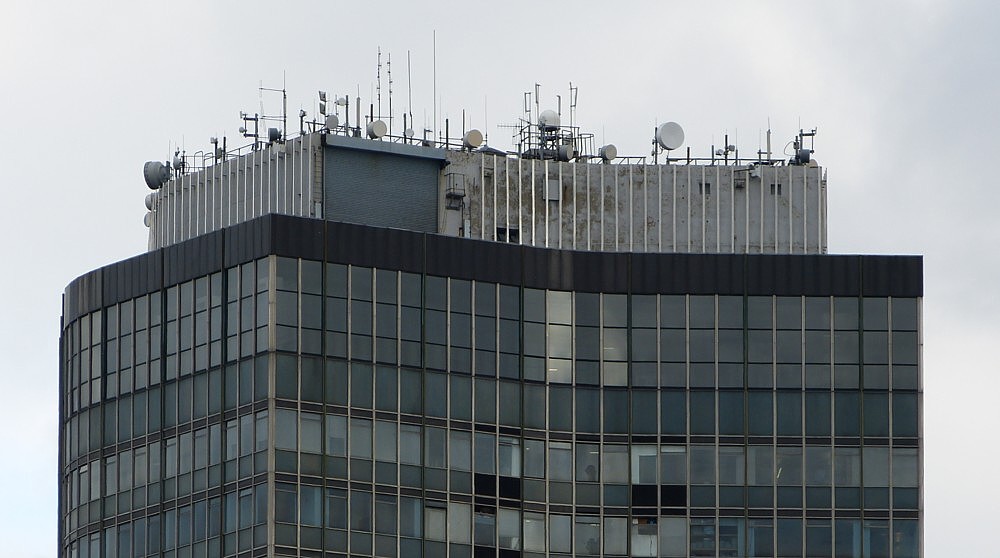
That’s the top of Millbank Tower, viewed from the point where Horseferry Road does its sharp right turn towards Victoria Street, or its sharp left turn towards the river, depending on which way you are going. (Me, I tend to go home, straight on along Regency Street.)
I tried cropping this picture even more, so that all there was was roof clutter, but this, I think, somewhat spoiled the effect. What I so much like about the top of Millbank Tower is the contrast between all that intricate techno-anarchy, and the architect-imposed blandness – the faceless face, so to speak – of the main building. Show only the techno-clutter, and you miss that contrast. Show it, and it makes the building look like the architectural equivalent of a blank-faced young man, with a crazy punk hairdo.
There is a similar contrast to be enjoyed in the last of these pictures, again of a big lump with a crazy roof garden of gadgetry. Roof garden is right, because all this stuff combines high-techness with the picturesque appeal of nature.
This is the picture I mean.
As regulars here will know, I am constantly fascinated by what goes on at the top of London’s buildings. I love the Big Tops that are built to impress, like the Shard, the Strata, the Gherkin. I love all the decorative stuff done in earlier centuries. I love chimney pots, which used to come in all shapes and sizes. And I love all the anarchic clutter that electronic communication of various sorts has placed at the top of otherwise utterly bland and forgettable blocks.
So here are some recent snaps, celebrating all that:
Those are shown in chronological order of me taking them.
1.1, 1.2 and 3.2 are are all quite near to me, taken in the vicinity of Warwick Way.
1.3 is the kind of thing you see when a big building site gets into gear, and then of course stop seeing when the work is done.
2.1 was taken in Lower Marsh, I think.
2.2 is Strata, also taken in Lower Marsh ish, peeping over a roof with a decorative knob on it.
2.3 is a bit indistinct, being roof clutter reflected off a big glass fronted building, but the clutter is there if you look.
3.1 is a bit of a cheat, because it is the umbrella that makes the picture, not the decorative roof (Parliament) behind it. But again, the roof is there.
3.2 includes the top of the big tower on the other side of the river from me, i.e. on the south side.
is a
3.3 is a big lump in Park Lane, as viewed from just inside Hyde Park, near Hyde Park Corner. I went with a friend to Hyde Park yesterday, hoping to view a statue of Colin Firth as Mr Darcy, emerging from the Serpentine. No luck. Gone. Or maybe just not where we looked.
I’m still on about last Tuesday, and about what a fine day it was to be taking photographs, and about what sort of photographs I took.
First there were those brightly coloured buildings, then the Tottenham Court Road grubbings, and now … the rest.
I confirmed that the weather was going to be just as fabulous as the weather forecasters had been saying for the best part of a week that it would be, from the moment I stepped out of my front door. Because, what I then felt was that very particular early spring experience, namely: feeling warmer than I did indoors. It comes from the bricks in my home being a heat store, or in the case of winter a cold store. To be more exact, the sun outside is hot and it warms up the air outside a treat, but it will take way longer for it to warm up those bricks, still busy sucking the heat out of my indoors.
So, I was in a fine mood from the start, and duly ticked off my official objective (plus second semi-official objective close by), so that the other half of the fun might begin. For me, the point is to get out there, preferably to places I have not visited lately, on a fine day, and to make sure I set forth with appropriate resolve and soon enough for it still to be light, I need an official objective. Those coloured buildings served that purpose very well. But then, there followed the unofficial pleasure, so to speak, of just meandering about and noticing things.
If you only click on one photo of those below, click on the first one, top left. That scene was actually quite a long way away, but thanks to the brightness of the sunshine and the power of my zoom lens, it looks like I’m right next to it.
Otherwise, there are my usual preoccupations. There is scaffolding, the other scaffolding being on Blackfriars Bridge, middle middle, where they are still finishing the new station on the bridge, with its oddly fluctuating roof. There are cranes, the same cranes each time, I suspect, on the top of a new erection arising somewhere on the other side of the river, between Waterloo and Tate Modern. And there is a particularly choice reflection effect, this time (I am almost certain) Tower 42 (the NatWest Tower that was) torched by the evening sun and reflected in the glass at the top of Tate Modern. There are bridges, no less then three in the picture bottom left, and five different bridges if you also count the ghostly columns of the Blackfriars Bridge that never was, next to Actual Blackfriars Bridge. And seven if you count the three views of the Millennium Footbridge as three different bridges. There is the Wheel, twice. And photographers of course, thrice.
I sought out the river because, as the light began to fade, by the river there would still be a huge (completely cloudless) sky full of the stuff to sustain me, in contrast to the streets north of the river where the light struggles to reach ground level.
As soon as I had finished looking at those brightly coloured buildings designed by Renzo Piano, I also took at look at the bottom of Centre Point, where they are doing Crossrail.
“Grubbings” is a word I inherited from my late father, along with his fondness for the thing that grubbings describes. Grubbings are big building projects in their early, especially below ground level, stage, when they are … well: grubbing, rather than building upwards. My father loved grubbings, and so do I.
It’s often hard to photo grubbings, because they often put a high fence around them and there’s no convenient high-up spot nearby to look over. But at this site, you can climb up some steps (top left) to a Centre Point entrance on the first floor, and photo through the mesh that you see in most of the other pictures.
Even with the internet, it can be hard to know how these kind of things are going to end up. Okay, here are these computer fakes of how they had in mind two years ago for it to be, but who knows if that’s still what they’re thinking.
There is also the fact that there are often so many images of how, at various stages in the design, they envisaged things looking, that it’s hard for a more casual onlooker to keep up. Simpler to just wait and see.
It reminds me of how the Brits confused the Argies during that Brits versus Argies war. Instead of not telling the Argies their plan, the Brits did tell the Argies their plan, and all the other plans the Brits might just as likely be following. The British newspapers were full to the brim with every imaginable plan. And the Argies were baffled, trapped in the headlights of too much information, all of it suspect of course. That’s sometimes how I feel when trying (admittedly not very hard) to find out how some big grubbings in a big city like London are going to end up looking.
Ever since I was reminded of those highly coloured buildings near Centre Point I have been meaning to check them out.
Yesterday, as I had been intending to do for several days, having known for several days of the excellent weather that would prevail yesterday, I did this.
Almost as striking as the buildings themselves are the reflections of their bright colours in nearby windows, and in fact my first clue that I was in the vicinity of my architectural prey was just such a reflection.
Here are some of the pictures I took, in the order I took them in:
I really liked these buildings. I had feared 70s style vulgarity. They are better than that, much better.
And I came to this conclusion before I learned, this evening, while concocting this posting, that they are the work of Renzo Piano. That’s right, the very same man who also designed the Shard:
You might also have once said the area was grey, but not any longer. If you go there now you will see a series of slabs of colour – orange, red, apple green and lemon yellow – vibrant as a row of casseroles in a Conran shop, rising 12 storeys into the sky. These belong to Central St Giles, a nearly complete office development by celebrated Italian architect Renzo Piano. “I wanted to make a building that smiles,” he says in explanation.
And to my eye he as succeeded. He hasn’t just supplied bright buildings. He has brightened up the whole area. I hope they don’t fade, or that if they do, they will be easily restored to their current brightness.
When photoing these colourful slabs of modernity, I concentrated on their sunny side, the south side. When the weather is warmer, I will surely return and check them out some more.
Yesterday, again, I ventured back across the river to see whatever I could see in the vicinity of that helicopter crash.
I couldn’t get near to where the worst of the drama unfolded on Wednesday, and I couldn’t yesterday, which is not a circumstance I would dream of complaining about. But today, as on Wednesday, I was able to gaze upwards again at that stricken crane, this time from the other side:
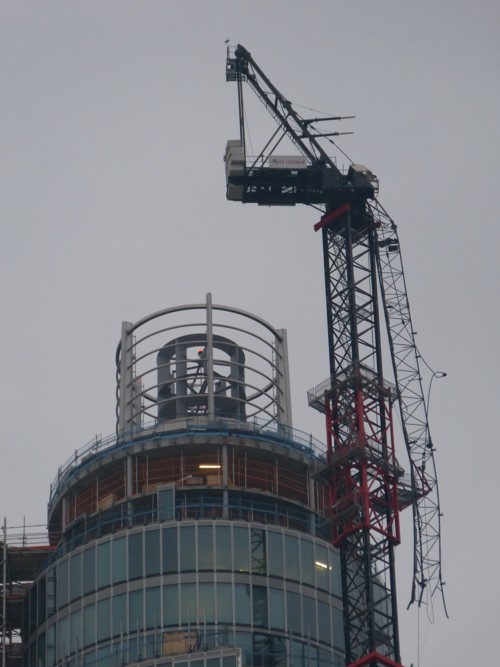
If you compare that picture with my earlier picture (immediately below), you will see that nothing up there has yet changed.
Other than the weather. Yesterday, and today, very grim and snowy. Also, I took the above picture just before it got seriously dark. The pictures below having been taken somewhat earlier. I did quite a bit of wandering around before I got that shot of the crane, but was very pleased when I finally got it.
On the ground, it is an entirely different story.
A whole new crane has arrived:
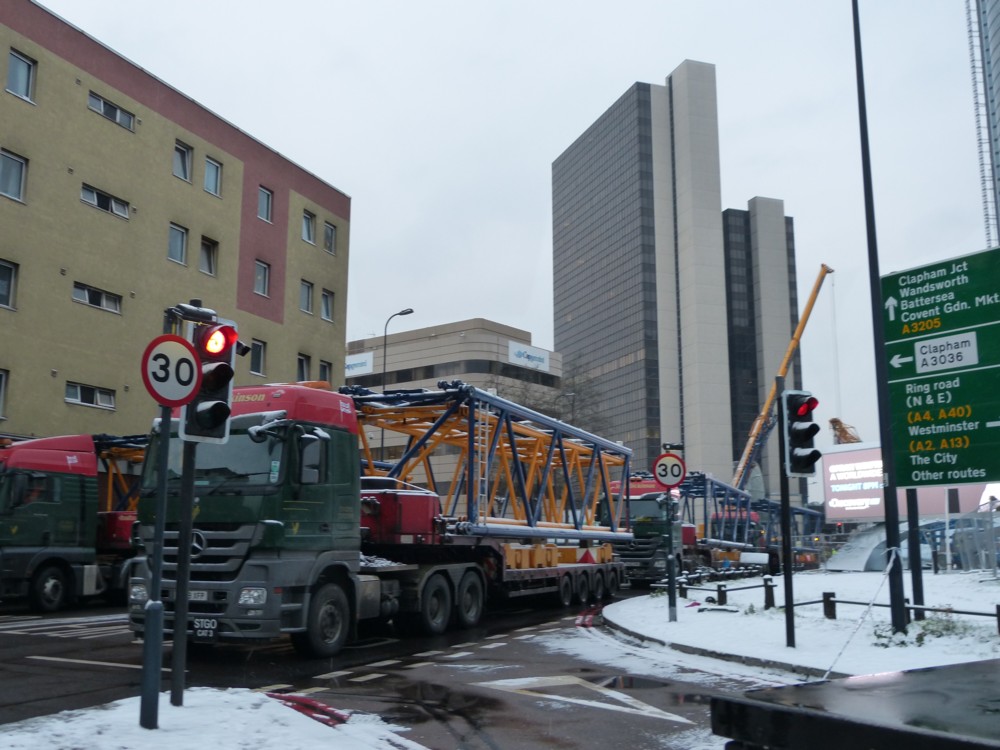
You can just see the edge of the tower there, above the road sign.
And that’s not the half of it:
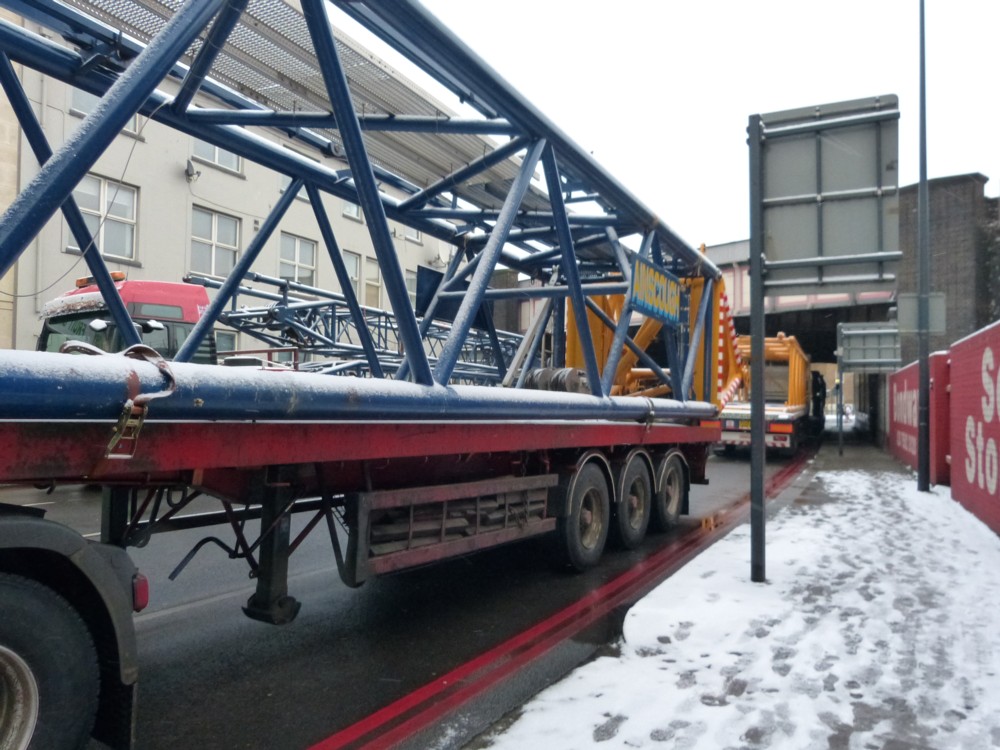
Altogether, about a dozen different articulated lorries had arrived, presumably earlier yesterday, and parked themselves in the roads at the other end of the new bus terminal from Vauxhall railway station. When I got there, there were still drivers in the cabs of several of these lorries. In total there were about a dozen lorries. These cranes are big. I’m guessing the economic situation means there were plenty of spare cranes to choose from.
And I further guess that these things have something to do with this crane:
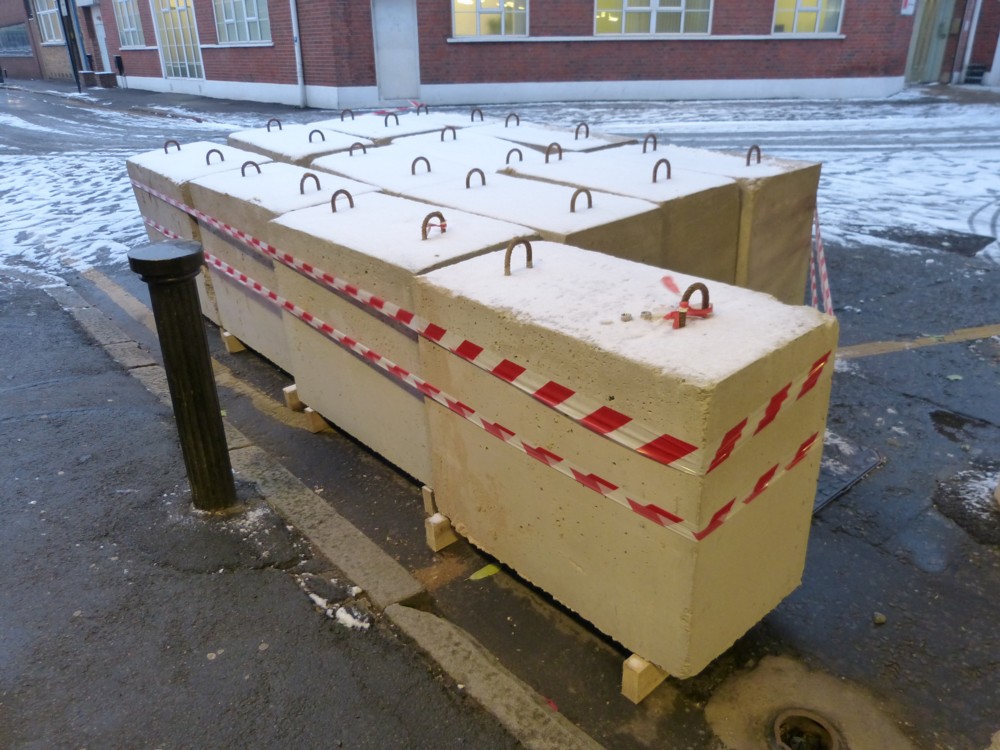
I assume that this new crane is about to be erected alongside the old and broken crane, to dismantle the broken crane, and then to finish the job of building the tower. How exactly will that look, I wonder?
Things are moving a lot faster than I guessed, to get the tower-building going again.
The tidying up from the crash seems to be taking place a bit further along the road, crucially not right next to the tower, and that process is happening simultaneously with getting the new crane in. The two jobs don’t clash. On the contrary they go together. Then, when the old crane is gone, and when the crash is cleaned up, the road will open again.
Is the plan to open the road again,after a weekend of feverish activity, on Monday morning? Definitely asap, it would seem.
 Yesterday I posted a short photo-piece at Samizdata about the Vauxhall helicopter crash, but had difficulty with the photos. Not having posted any photos on Samizdata for about a month, I had to rediscover how to do it. I am definitely not going to be switching to WordPress here any time very soon. Although, come to think of it, maybe I will switch soonish, if only to be able to practice posting photos on WordPress, here. Given that here I allow myself to do any damn fool thing I feel like doing. Like not post anything for a week, for no good reason.
Yesterday I posted a short photo-piece at Samizdata about the Vauxhall helicopter crash, but had difficulty with the photos. Not having posted any photos on Samizdata for about a month, I had to rediscover how to do it. I am definitely not going to be switching to WordPress here any time very soon. Although, come to think of it, maybe I will switch soonish, if only to be able to practice posting photos on WordPress, here. Given that here I allow myself to do any damn fool thing I feel like doing. Like not post anything for a week, for no good reason.
So anyway, here is a photo (a slice out of the photo I did post at Samizdata) which I tried to post at Samizdata yesterday, late last night, but got in a muddle with and gave up on. Now, I will embed a link to this, from there.
The problem with photoing this ruined crane is, for me, getting into a good position. This was the best shot I could get yesterday, given that I was in a hurry because of fading light. What I may now try is photoing it from one of the platforms of Vauxhall Station, which is the other side of the crane from where I was yesterday. Station platforms being long, you can move back and forth until you get the best shot. Today looks like nice weather, so maybe I’ll try that this afternoon.
I need more text here, to fit the photo into this posting without it bashing into the previous posting. So, what else to say about this?
Well, one thing I can say is that I am extremely curious about how they will sort this out. I guessed in my Samizdata piece that it will be a while before they get around to sorting out this crane, because on the ground they have other things to sort out, involving thousands of commuters going to and fro every day, on the road onto which the stricken helicopter fell, spreading flames everywhere. The builders will just not be first in the queue. The builders will be needing the road when they bring in whatever other cranes they need, to remove the ruined crane, and to put up another crane, so I’m guessing they’ll have to wait until the road is sorted and back in business.
Plus, do they mend the crane, or replace it? Does anyone know what the routine is for fixing a crane in this state, on a site like this one? As I understand it, the entire tower-building job depends on that crane, and now the entire job comes to a shuddering halt, until they can get that crane mended, or another crane into that same spot. Heaven knows what that delay will cost, per hour.
I hope I get really lucky and get to photo them sorting this out, but am not optimistic. Building contractors are not in the habit of drawing attention to themselves when they are busy building. They just want to be left alone to get on with it. The press-releasing, attention-grabbing phase only gets under way when the building is good and finished.
That ought to be enough text.